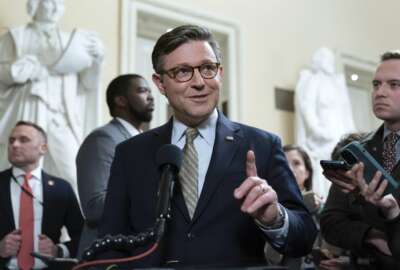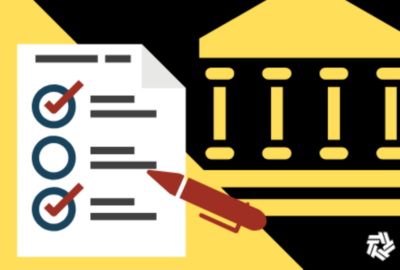Agency officials make their ‘efficiency’ pitch. Trump’s transition team takes note
Amid the transition, agency officials leading customer experience efforts across the federal government are pitching their work to the incoming administration.
Weeks out from Inauguration Day, presidential transition efforts are in their final stages, as President-elect Donald Trump prepares to take office.
Amid these transition efforts, the incoming Trump administration is launching a Department of Government Efficiency, led by billionaire businessmen Elon Musk and Vivek Ramaswamy.
DOGE will advise the Office of Management and Budget to cut government spending and streamline operations.
Musk and Ramaswamy have spent the past few months pitching their government efficiency plans on social media, newspaper op-eds and media interviews. Their government efficiency plans include uncontroversial ideas, like phasing out obsolete government IT systems, as well as unconventional ideas, such as significant cuts to the federal workforce.
Amid the transition, agency officials leading customer experience efforts across the federal government are pitching their work to the incoming administration as a key piece of an efficiency playbook.
Customer experience in the federal government is at a seven-year high, according to an annual scorecard tracked by the American Customer Satisfaction Index.
Agency websites generally saw higher satisfaction scores for their websites than their call centers. Agencies also saw higher scores on handling customer complaints — and outperformed industries such as TV subscription services, food delivery, internet service providers and social media sites.
Federal customer experience officials, speaking at a Nov. 15 CX summit hosted by ACT-IAC, say these improved scores build on more than a decade of momentum across multiple administrations — including the prior Trump administration — and are urging incoming Trump administration officials to keep building on these efforts.
Their transition advice is reaching at least some members of its intended audience. Federal News Network has learned Trump transition team officials attended the CX summit.
While the Trump transition team is charting a different course from the Biden administration on many key policy areas, the incoming and outgoing administrations may take similar steps to make government benefits and services more accessible to the public. The first Trump administration made customer experience in government a pillar of its President’s Management Agenda.
The customer experience movement in government, in some cases, emerged from moments of crisis.
The Department of Veterans Affairs stood up its Veterans Experience Office in the year following a 2014 scandal, in which staff at VA hospitals falsified wait lists for medical appointments.
Lee Becker, former chief of staff for VA’s Veterans Experience Office, now senior vice president and executive advisor for public sector and health care at Medallia, said before customer reform efforts took root at the VA, veterans in some cases called the VA 78 times to get information from the department.
“Think about it, 78 times. Is that efficient? No. But now, because we’re improving that experience, VA has been doing that, and many agencies are doing that as well, you’re able to actually reduce the time-to-serve and actually able to increase efficiency,” Becker said.
The VA is now providing records levels of health care and benefits to veterans and their survivors. The department is also seeing its highest veteran trust scores since it began conducting this survey in 2016.
Deputy Chief Veterans Experience Officer Barbara Morton said the VA has come a long way to providing “easy, effective, and emotionally resonant” service to veterans — and urged the next administration to keep putting momentum behind this work.
“It’s just about being better to those that we are charged and entrusted with serving,” Morton said. “My personal experience with any transition has actually been great. I don’t think I’ve met anybody on a transition team that disagrees with the philosophy of, “We’ve got to deliver the best we can to those that we serve.’ It’s not about putting the bureaucracy first.”
“This, to me, is about what good government is supposed to be. And going forward in any transition, I think, reflection is natural. The opportunity before us is immense. Every agency is at a different place. But I am super excited to see where we can take it together at the next level,” she added.
Federal Chief Information Officer Clare Martorana said the federal government, under President Joe Biden’s customer experience executive order, has “made great strides” in serving the public. However, Martorana said agencies still have more work to do, adding that “an enormous amount of the connective tissue of government is paper.”
“If you want to talk about efficiency, that is where we can become more efficient,” Martorana said. “We have 45 forms to accomplish one task. We collect the data in completely crazy silos. Breaking down those barriers is what the opportunity is. Leading with the customer and the customer’s voice is going to resonate with anybody who is coming into government, wanting to be a champion of efficiency and productivity.”
Under Martorana’s leadership, OMB gave agencies guidance on providing a digital-first, but not digital-only customer experience. As part of finalizing this guidance, Martorana said OMB conducted a first-of-its-kind inventory of government websites.
“You wouldn’t think that that was a novel thing, but we had never counted them before — just the dot-govs. But there are also dot-orgs and dot-edus. There’s inefficiency in the way we’ve stood up a lot of our digital services, “Martorana said. “Understanding how you are engaging with your audience, what the utilization is of all of those digital channels, is really the most foundational thing to start.”
The Trump transition team is following some conventional procedures, as it prepares for the new administration, but is also giving itself a shorter runway than most transition teams to complete those tasks.
The transition team signed a memorandum of understanding with the White House in late November that will allow landing teams to receive briefings from agencies. Last month, the team signed another memo with the Justice Department that allows Trump’s top political appointees to go through the security clearance process.
“They will be tasked with coming in, and a landing team is going to try and learn and get those binders and absorb a lot of information. But the reality is they aren’t going to know everything,” Martorana said about the landing teams. “They’re not going to know your acronyms. They’re not going to know your bureaus and silos. So, make it easy for them, because as soon as you make it easy for them and they understand what you’re trying to do, you’re off to the races. They will continue to remember that the customer is the center of our missions, and I think that that will really help propel your efforts forward.”
Martorana also urged agency officials in transition meetings to “know your numbers,” and come prepared with performance metrics.
“Everybody’s going to come in, and they need to be oriented,” she said. “Good folks are going to come in and be part of a transition team, and they’re going to sit down, and they’re going to want to understand the ecosystem. When I joined my team, my orientation was basically an org chart. An org chart tells you one story, but it doesn’t tell you the entire story.”
Martorana said customer experience reform efforts across government will accelerate as agencies adopt more artificial intelligence tools.
“What gets me incredibly excited is all of the new technology, AI. Things that are going to speed the way that we deliver services to the public, the way that we utilize technology, the way that we actually build out our teams and do work together. So I’d say that we’ve improved greatly in the time I’ve been here, seeing this journey mature … But we still have a long way to go. And I’m really excited about what’s in store for the next four or five years. Because I think it’s going to be exponential innovation and growth,” she said.
‘Long-term, sustainable tactics’ for efficiency
Jennifer Pahlka, founder of Code for America and a former U.S. Deputy Chief Technology Officer who helped launch the U.S. Digital Service, now a senior fellow at the Niskanen Center, said it’s not usual for an incoming administration to reframe the work of government technologists and customer experience experts. In prior adminstrations, she said much of this work fell under a banner of “innovation,” but nevertheless continued.
“I don’t think it’s innovation. I think it’s getting to basic practices. It’s clearing the clutter. In customer-focused tech companies, for instance, it’s just basic work. You don’t need to reinvent it,” Pahlka said.
Pahlka, in a recent blog post, wrote that the Trump administration’s plans for Schedule F, if managed carefully, could address bipartisan calls to reform a nearly 50-year-old civil service system. Part of that reform, she added, means holding poor-performing federal employees accountable.
“I think it’s a pro-public servant thing, because public servants want to be able to have effective teams and not have just a small handful of underperformers pulling their team down. That’s a great efficiency move, that people who really know D.C. and know how federal government works could help DOGE do that would also be much more sustainable,” she said.
Pahlka, however, said Ramaswamy’s proposal to eliminate up to 75% of the federal workforce at random, based on whether their Social Security number ends in an odd or even number, does nothing to make the federal workforce more accountable.
The last major overhaul of the federal workforce happened in 1978, when former President Jimmy Carter signed the Civil Service Reform Act. The legislation gave rise to the Senior Executive Service, the right for non-postal federal employees to collectively bargain and whistleblower protections. Federal workforce experts say the time for Congress and the White House to revisit the topic is overdue.
“Coming in and saying, ‘We’re just going to cut budgets and we’re going to cut headcount,’ you get a different administration in four years and they just reverse that. I actually want DOGE to think about far more long-term, sustainable tactics that they could take that will really result in a healthier federal government, no matter who ends up in charge four years from now,” Pahlka said.
“When it’s a difference between firing half of federal employees based on their Social Security number and doing civil service reform, you know which one’s harder? Doing civil service reform. In some ways, what I’m trying to say to them is, ‘This is a cop-out, do the hard work.’ In some ways, I’m saying, ‘Do more, but do the right thing and work with Congress and work with OPM.’ We don’t want to just hope that they do as little as possible and leave,” she added.
IRS seeks CX improvements amid budget cuts
The IRS is aiming for a similar turnaround in its level of customer service for taxpayers. Under the Inflation Reduction Act, the IRS initially received $80 billion in multi-year modernization funds to build up its workforce and modernize its legacy IT, after more than a decade of budget and staffing cuts.
The agency spent its first tranche of Inflation Reduction Act spending on hiring 5,000 customer service representatives to staff call centers. It’s also using the money to shift its largely paper-based workload to a digital format. IRS Chief Taxpayer Experience Officer Fumi Tamaki said the agency is looking to eliminate hurdles that frustrate taxpayers and frontline IRS employees.
“You quickly realize, just like in the private sector, behind every painful customer experience is a painful employee experience. And that could not be more true for our employees at the IRS,” Tamaki said.
Tamaki said IRS call center employees often have about eight to 10 different windows open on their computer screens, “because there are so many different places that a customer service rep will need to look at to get taxpayers’ different information.”
“What was the notice that they received? What is their balance due? What is their unique situation that they’re in, that they’re calling about? You almost have to do forensics through different windows to understand exactly how an employee can help that taxpayer,” she said.
The IRS is simplifying 200 of the most commonly mailed notices it sends to taxpayers. Tamaki said the IRS is “well past” the halfway point of redesigning those notices.
“We obviously want to put notices online and have the ability for people to respond to notices online. That seems like table stakes. My lesson learned from my first year of being at the IRS was, well, it’s much easier to fix that stuff. What’s really hard is what’s happening on the inside,” she said.
The IRS, however, will have a harder time moving ahead with these projects as Congress keeps cutting its Inflation Reduction Act funding. Lawmakers agreed to a $20 billion IRS funding cut during 2023 negotiations to raise the nation’s debt limit.
The agency saw another $20 billion cut to its modernization fund last month, when Congress passed a continuing resolution to avoid a government shutdown. Lawmakers did not include language in the stopgap spending bill to prevent an automatic $20 billion cut in a previous CR that ran from Oct. 1 through Dec. 20 last year.
Musk raised the idea of IRS budget cuts in a poll he posted on X (formerly Twitter) in November. A majority of poll recipients say the IRS’ budget should be “deleted” or “decreased.”
Meanwhile, House Republicans are calling on Trump to pull the plug on IRS Direct File.
The IRS tested its free, online tax filing platform with 140,000 taxpayers in a dozen states, as part of a pilot this year. The agency planned to expand to 24 states this year as a permanent program.
But nearly 30 GOP lawmakers are calling on Trump and the heads of his Department of Government Efficiency to kill the program in an executive order on his first day in office. The lawmakers say they don’t support the IRS using its funding to support Direct File, when there are other ways for taxpayers to file online.
DOGE’s position on Direct File, however, is not entirely clear. The Washington Post first reported in November that Musk and Ramaswamy have discussed trying to create a mobile app for Americans to file their taxes with the IRS for free.
The nonprofit organization Code for America partnered with several states to help launch their own state-level tax filing platforms that integrate with Direct File.
Code for America CEO Amanda Renteria said the IRS’ work on Direct File shows “you can change something from a dreaded experience to something people actually appreciate — or at the very least, you can see a change in something you have to interact with in government all the time.”
“Our way of thinking about reforming government, transforming government that we’ve been doing over several years is not just about efficiency. It really is how do you make sure to make government as effective as possible for all people,” Renteria said.
Renteria said the IRS developed Direct File the same way Silicon Valley tech companies would design a product – by starting small, gradually developing new features with user feedback and beta-testing it with a smaller set of customers before making it available more broadly.
“I really encourage anyone on the commission to take a look at how this particular product was built within government, because it is an unusual path. It was iterative, it was small, moved big, and now ready to really be all across the country,” she said.
Copyright © 2025 Federal News Network. All rights reserved. This website is not intended for users located within the European Economic Area.
Jory Heckman is a reporter at Federal News Network covering U.S. Postal Service, IRS, big data and technology issues.
Follow @jheckmanWFED






